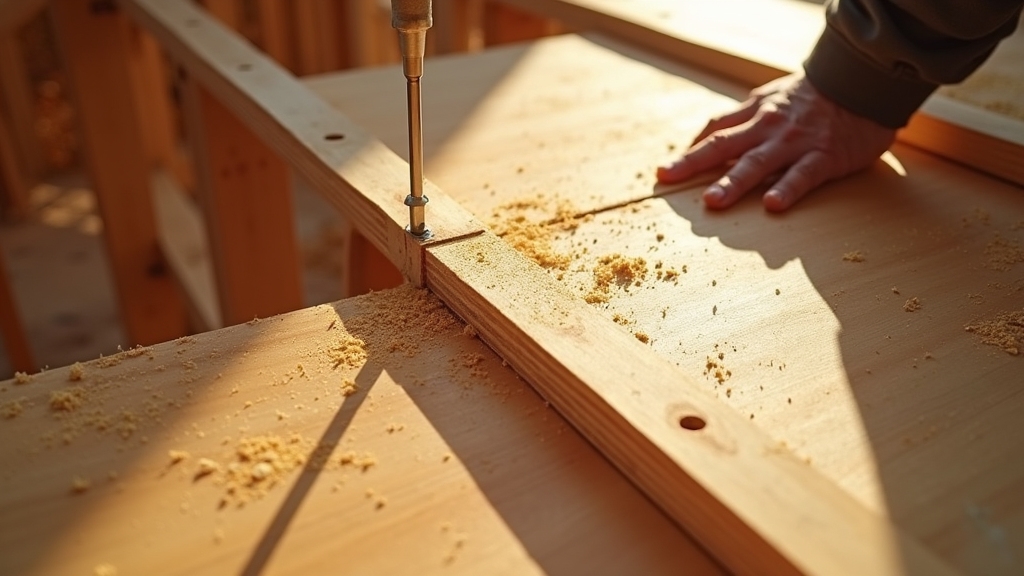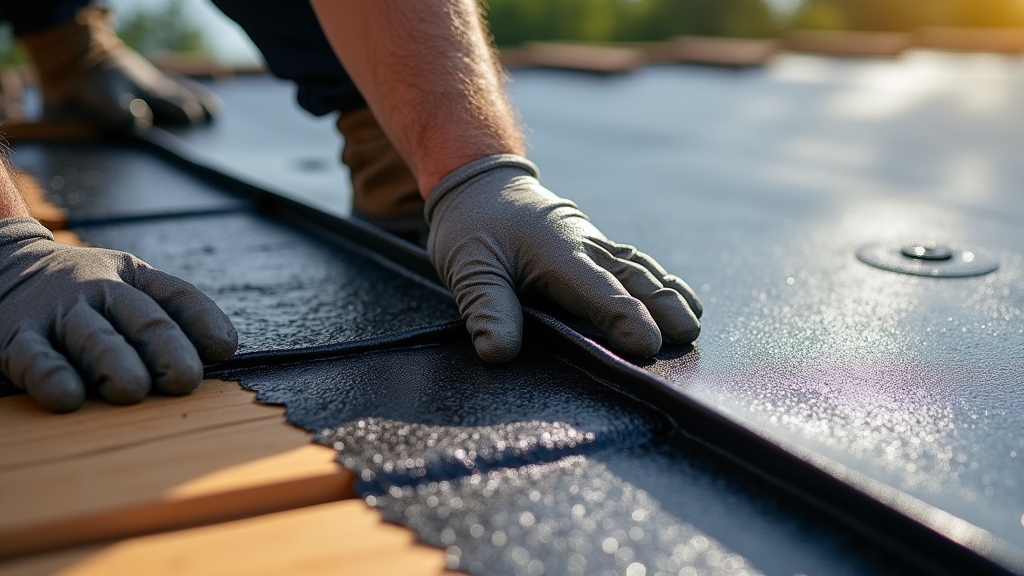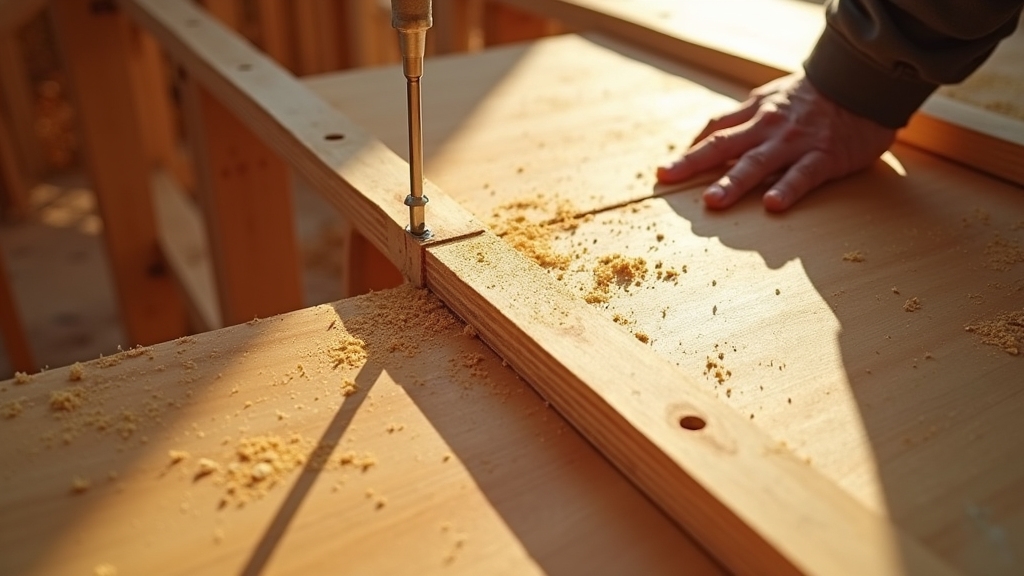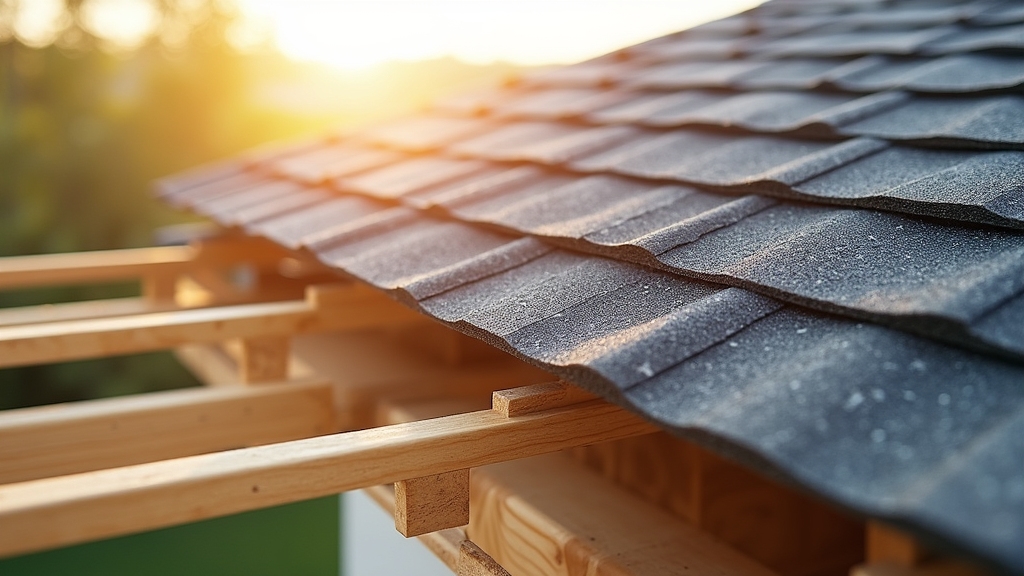A durable roof is a layered system. Decking (OSB/plywood) spans framing and takes fasteners. Underlayment provides a secondary water-shedding surface; laps and perm rating must match slope and climate. Ice-and-water shield protects eaves, valleys, and penetrations, installed on clean, dry substrates. Metal flashing and compatible sealants manage joints and movement. Ventilation balances soffit intake with ridge exhaust; insulation and vapor control prevent condensation. Roofing materials—shingle, metal, tile, slate—are selected for load, fire, and wind ratings. The next sections explain how these choices integrate.
Key Takeaways
- Roof decking is the structural base, transferring loads to framing; panel orientation, gaps, and fastener schedule are critical for strength and wind resistance.
- Underlayment is the secondary water-shedding layer; lap details and permeance must match roof slope, climate, and ventilation strategy.
- Ice and water shield protects eaves, valleys, and penetrations from ice dams and wind-driven rain; install on clean, dry decking with staggered seams.
- Flashing and sealants manage water at joints and penetrations; step and counterflashing, boots, and crickets create reliable drainage paths.
- Ventilation, insulation, and material choice work together; balanced intake/exhaust airflow and appropriate vapor control prevent condensation and extend roof life.
Roof Decking: The Structural Foundation

Roof decking forms the structural substrate of a roof system, transferring loads to rafters or trusses and providing a nailable surface for underlayment and roofing. Selection, fastening, and detailing govern performance and code compliance.
Common materials include OSB and plywood; thickness is set by span, live/snow/wind loads, and panel grade, per ICC/IBC/IRC and APA span ratings. Panels are installed with long dimension perpendicular to framing, with 1/8-inch panel edge gaps and H-clips where required to control differential movement and support edges.
Use OSB or plywood sized by spans and loads; install perpendicular, gap 1/8 inch, add H-clips as required.
Fastener type, length, and spacing are critical: typically ring-shank nails or screws, sized to penetrate framing adequately; spacing tightens in high-wind zones per ASCE 7 and local amendments.
Blocking at panel edges is specified when spans or diaphragm shear demands exceed clip capacity. Ventilation clearances at eaves and ridges must be protected without compromising diaphragm continuity.
Fire-resistance, preservative treatments, and corrosion-compatible fasteners are selected to suit exposure, species, and jurisdiction.
Underlayment: The Moisture Barrier
A secondary water-shedding layer, roof underlayment bridges between decking and the final roofing, managing liquid water, wind-driven rain, and vapor diffusion while protecting the deck during construction.
Its selection and installation govern roof longevity and code compliance. Materials fall into asphalt-saturated felt and synthetic polymer sheets, with specialized self-adhered membranes outside this scope. Felt (Type I/II) offers workable breathability but variable tensile strength and dimensional stability; synthetics deliver higher tear resistance, lighter rolls, and improved UV holdover.
Code-driven performance hinges on slope, climate zone, and roof covering. Fastener schedules, overlaps, and terminus details are defined by manufacturer instructions and IRC/IBC references.
Typical laps: 2 inches horizontal, 4 inches end, increased on low-slope planes. Valley and penetration connections require shingled layering, sealed fasteners, and wrinkle-free substrates to prevent capillary backflow.
Permeance selection must coordinate with attic ventilation and interior vapor control to avoid interstitial condensation. UV exposure limits and walkability ratings dictate staging and sequencing.
Ice and Water Shield: Extra Protection in Vulnerable Areas

Beyond standard underlayment, self-adhered ice and water shield targets zones prone to water intrusion—eaves, valleys, rakes, hips, sidewalls, skylights, and penetrations. This membrane’s rubberized asphalt or butyl adhesive bonds to the deck, sealing around fasteners and resisting capillary backflow. Proper selection matches climate, deck substrate, and roof covering: high-temp formulations for metal or dark shingles; low-temp flexibility for cold installs; granulated vs. smooth surfaces per manufacturer requirements.
Installation is substrate-dry and clean, with shingle-lap orientation. At eaves in ice-dam regions, codes typically require coverage from the edge to at least 24 inches inside the exterior wall line; steeper pitches may reduce that distance. Valleys receive full-width sheets centered and shingle-lapped upslope.
Side interfaces and long rakes benefit from continuous strips to mitigate wind-driven rain.
Maintain vapor-control strategy: on conditioned decks, prevent double vapor barriers by coordinating with underlayment type. Terminations are roll-pressed, wrinkle-free, with staggered seams.
Flashing and Sealants: Guarding Joints and Penetrations
While shingles shed bulk water, joints and penetrations remain failure points unless detailed with properly selected flashing and compatible sealants.
Metal flashing—commonly galvanized steel, aluminum, or copper—creates durable, shingled water paths at step, headwall, sidewall, and valley connections. Step flashing laps each course; counterflashing engages the vertical substrate, interrupting capillary paths. Pre-formed boots with malleable skirts seal pipe penetrations; cricket or saddle flashing diverts flow behind chimneys.
At low-slope interfaces, continuous apron and curb flashings must extend per manufacturer and code minimums, with hemmed edges and corrosion compatibility.
Sealants are secondary, not primary, weather barriers. Polyurethane or silyl-terminated polyether products bond to metal, masonry, and coated membranes; neutral-cure silicones suit high-UV zones but demand clean, primed substrates.
Joint design follows movement class, backer-rod sizing (2:1 width-to-depth), and bond-breaker practice to avoid three-sided adhesion. Fasteners receive compatible sealant and gasketed washers. Terminations align with WRB laps, ensuring positive drainage.
Ventilation and Insulation: Balancing Airflow and Energy Efficiency
Effective roof assemblies pair balanced attic airflow—intake at eaves, exhaust at ridges, and continuous baffles—with insulation that meets climate-zone R-values and maintains a vent channel where required by code.
Material selection compares fiberglass, cellulose, mineral wool, and closed- or open-cell spray foam for thermal resistance, air sealing, and ignition/condensation control.
Moisture management integrates Class I–III vapor retarders as appropriate, taped air barriers, and controlled ventilation to prevent condensation at the roof deck and within the attic.
Attic Airflow Strategies
Two complementary systems govern attic performance: ventilation to manage moisture and heat, and insulation to control conductive and convective losses.
Effective airflow begins with balanced intake and exhaust. Soffit vents provide low, continuous intake; ridge vents supply high, continuous exhaust, exploiting stack effect. Where ridges are impractical, code-compliant gable or roof louvers fill the role, sized by net free area and corrected for screening.
Baffles maintain a clear ventilation channel above the thermal boundary and prevent wind-washing at eaves.
In mixed and cold climates, target 1:300 net free ventilation area to ceiling area when a Class I or II vapor retarder is present; otherwise use 1:150.
Avoid short-circuiting by separating intakes from exhausts. Seal duct penetrations. Use smart, humidistat-controlled fans only when passive paths are constrained.
Insulation Types Compared
Although airflow sets the stage, thermal control hinges on selecting and detailing the right insulation for the roof-assembly type. Comparative performance depends on R-value per inch, continuity, fire/ignition barriers, compressive strength, and compatibility with vented or unvented assemblies per IRC/IECC.
1) Polyiso (foil-faced): high R/inch, excellent for above-deck continuous insulation; requires thermal barrier at interior, watch facer temperature limits, and account for R-value reduction in cold climates.
2) XPS/EPS: robust moisture resistance and compressive strength for over-structure use; verify LTTR, blowing-agent GWP, and tapered packages for drainage; protect edges at parapets.
3) Closed-cell spray polyurethane foam: air-impermeable, structural adhesion, ideal for unvented assemblies; control lift thickness, substrate temperature, and ignition barriers.
4) Mineral wool boards/batts: noncombustible, dimensionally stable, good acoustic value; use high-density boards above deck, maintain wind uplift resistance with correct fastener patterns and plates.
Integrate continuous insulation to mitigate thermal bridges at framing, eaves, and penetrations. R-values must meet climate-zone tables.
Moisture Control Methods
With insulation strategy established, moisture management must address both vapor diffusion and bulk air transport to prevent interstitial condensation and material degradation. Effective assemblies pair airtightness with calibrated ventilation, using continuous air barriers, sealed penetrations, and balanced intake–exhaust pathways. In cold climates, interior-class vapor retarders (Class II or smart membranes) limit winter diffusion; in mixed or humid climates, outward-drying, vapor-open layers with exterior continuous insulation mitigate summer vapor drive. Vented attics require code-minimum net-free area sized per roof geometry; unvented “compact” roofs rely on sufficient above-deck R-value and adhered membranes. Hygrothermal modeling (e.g., WUFI) verifies drying reserves.
| Method | Purpose |
| Air barrier continuity | Block convective moisture |
| Smart vapor retarder | Seasonally adaptive diffusion control |
| Above-deck rigid insulation | Keep sheathing above dew point |
| Balanced ridge/soffit vents | Pressure-neutral airflow |
| Commissioning and testing | Verify airtightness and ventilation rates |
Roofing Material Options: Shingles, Metal, Tile, and More

Selecting between asphalt shingles, metal panels, and tile or slate assemblies hinges on structural load capacity, fire rating (Class A), wind uplift resistance (per ASTM/UL), and local climate exposure.
Asphalt offers cost efficiency and easier repair, while metal delivers superior longevity, lower weight, and cool-roof options.
Tile and slate provide exceptional durability but require reinforced framing and strict underlayment and flashing details.
Code-compliant specification should address underlayment type, fastener pattern, ice-barrier extents, and ventilation compatibility for each material system.
Asphalt vs. Metal
When evaluating asphalt shingles against standing seam or corrugated metal panels, the comparison centers on service life, load and wind performance, fire classification, and lifecycle cost under relevant codes (IRC/IBC) and manufacturer specifications.
Asphalt shingles (ASTM D3462) typically deliver 20–30 years, rely on felt or synthetic underlayment, and require balanced attic ventilation per IRC R806.
Metal systems (ASTM E1592, AISI S100) can exceed 40 years, demand continuous or clip-fastened attachment over solid decking or purlins, and integrate high-temp underlayments at heat-prone zones.
- Wind uplift: Shingles rated per ASTM D7158; metal per UL 580/1897 with higher design pressures.
- Fire: Class A via UL 790 achievable for both with compliant assemblies.
- Structural: Metal limits governed by deflection and clip spacing.
- Cost: Asphalt wins initial; metal wins lifecycle in corrosivity-managed environments.
Tile and Slate
Tile and slate occupy the premium end of steep-slope roofing, offering long service life, high fire resistance, and robust wind performance when detailed per code and manufacturer criteria.
Clay and concrete tile require engineered fastening patterns, approved underlayments, and battens or direct-deck attachment per ICC-ES reports. Dead load ranges from roughly 8–12 psf for slate and 9–15 psf for tile; structural verification of rafters, sheathing, and connections is mandatory.
Underlayment selection should match climate: ASTM D226 Type II felt, SBS-modified base sheets, or synthetic underlayments with high temperature ratings above vented spaces.
Slate systems rely on headlap (typically 3 inches), copper or stainless nails, and flashings to ASTM B370 or A240.
Eave, valley, and hip details demand preformed metals, counterflashing, and secure mechanical anchorage.
Frequently Asked Questions
How Do Roof Warranties Differ Between Manufacturers and Installers?
They differ by scope and privity: manufacturers warrant materials against defects; installers warrant workmanship and integration. Terms vary in duration, transferability, wind/hail coverage, exclusions, required maintenance, and code-compliant installation. Full-system warranties demand certified contractors, approved assemblies, registration, and documented inspections.
What Maintenance Schedule Extends the Life of a Roof System?
A semiannual plan extends service life: spring/fall inspections, debris removal, sealed penetrations, prompt flashing fixes, gutter/downspout clearance, ponding remediation, fastener re-torque, membrane/cap sheet repairs, algae control, attic ventilation check, insulation moisture checks, post-storm assessments, and documented work per manufacturer requirements and IBC/IRC.
How Do Local Building Codes Impact Roof Layer Choices?
Local building codes dictate permissible materials, fire and wind ratings, vapor control layers, insulation R-values, fastener patterns, slope thresholds, and underlayment types; consequently, designers select assemblies meeting jurisdictional amendments, manufacturer listings, and test standards (e.g., ASTM, UL, FM) to guarantee compliance.
Can Solar Panels Be Integrated Without Compromising Roof Layers?
Yes. With flush-mounted racking, flashed or fully adhered mounts, proper underlayment, and sealed penetrations, solar panels integrate without compromising layers. Verify structural loads, fire classification, wind uplift, and water-shedding per manufacturer instructions, UL 2703/1703, and local code.
What Roofing Components Affect Homeowners Insurance Premiums?
Roofing components affecting premiums include deck material, underlayment type, slope, fastening systems, impact-rated shingles, fire class, wind uplift rating, age, flashing integrity, ventilation, secondary water barriers, skylights, penetrations, drainage design, and code-compliant installation documented via permits, inspections, and certifications.
Final Thoughts
A roof performs best when every layer works as one system: solid decking for structural continuity, correctly fastened underlayment with targeted ice-and-water shields in vulnerable zones, well-detailed metal flashing with compatible sealants, balanced ventilation and insulation, and a climate-appropriate roof covering—asphalt, metal, tile, or slate—installed to code and manufacturer specs. Do that, and you get predictable durability, fewer callbacks, and long-term protection for your home.
If you’re ready to evaluate your roof or plan an upgrade, partner with a contractor who lives this systems approach. Premiere Roofing Macomb delivers code-compliant, warranty-ready solutions for residential roofing, detailed roof inspections, and full roof replacements—including material options like asphalt shingles, metal roofing, and composite roofing.
Start with a professional assessment to confirm deck condition, underlayment strategy, flashing upgrades, and ventilation balance—then select the best material for your load, fire, and wind requirements.
Contact us today request your free, no-obligation estimate today via our Contact Page or explore all services. We’ll help you design a roof that’s durable, efficient, and ready for Michigan weather.

